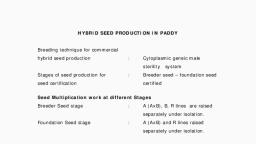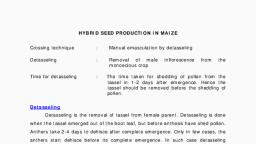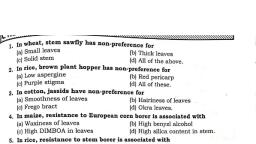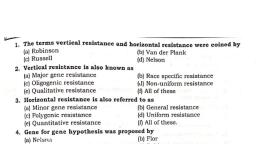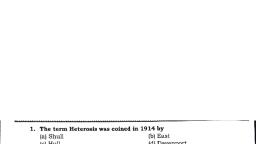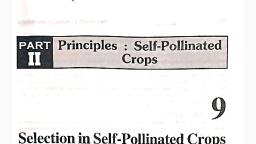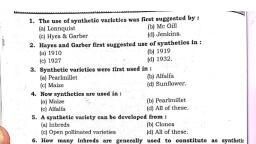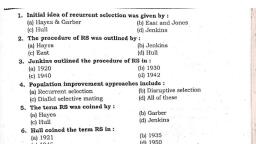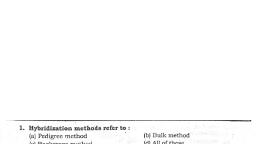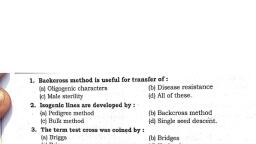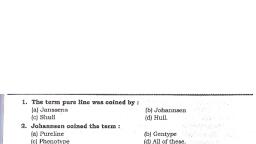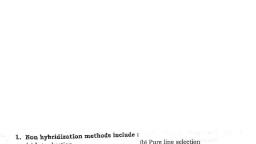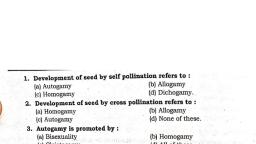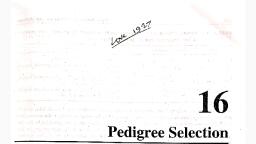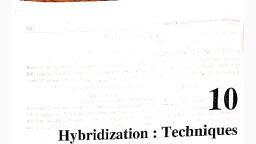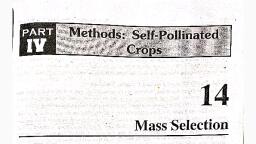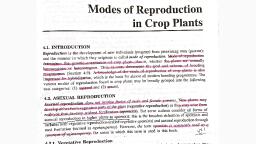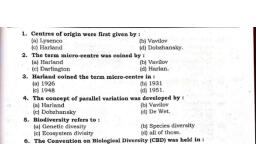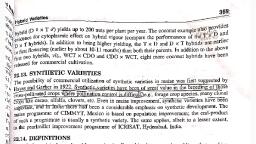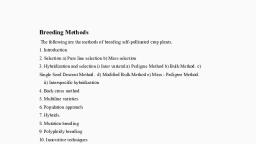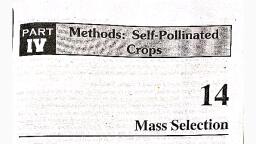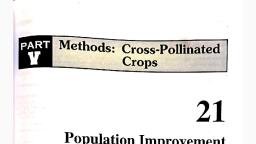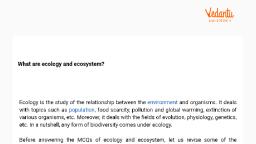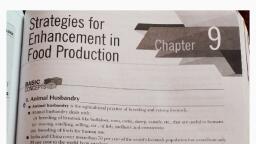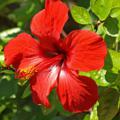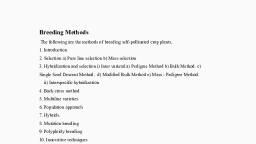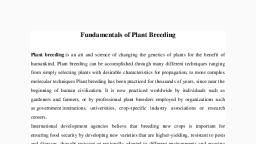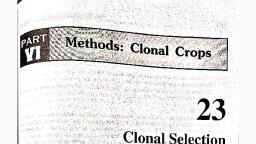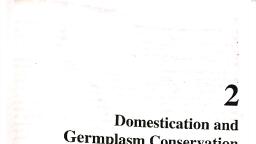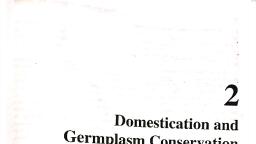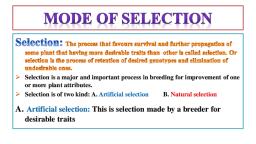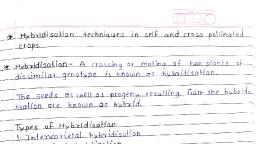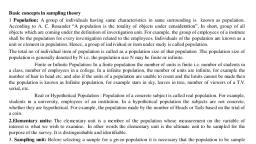Page 1 :
~, é, , seveloped during T940s, particularly after 1945, when (Hfull/, , 21.7. RECURRENT SELECTION, , and Garber in-1919.und, independently,, , nemes Of recurrent selection -were, , , , , owever, cohesive in, , , , n, , ility. The recurrent sélection “schemes were~), devised tn relation to heterosis breeding with a view to improve the chances of isolation of fet, superior inbreds from the populations improved by recurrent selection. The probability of isolating, , ia Goiaading inbred line depends primarily on two factors: (YY the proportion of superior, Benotypes present in the base population, from which inbreds are isolated, and {2ythe effectiveness, , of selection. during the inbreeding process, in increasing the frequency of desirable genes or gene, Combinations. The available evidence clearly indicates that selection is ineffective in preventing, , Scanned with CamScanner
Page 2 :
326 Plant Breeding : Principles ang Met,, Otis, , a random fixation of genes even with mild inbreeding. Thus even strict selection is not [i, enhance appreciably the chances of isolating an outstanding inbred from a Population, T, the breeder has to increase the frequency of favourable genes and genotypes in the base p, using a breeding scheme that would keep inbreeding to a minimum., , Recurrent:selection schemes: are variations. of progeny-selection. They differ from sip,, rogeny selection schemes (1)'in the manner of obtaining the progeny for evaluation, ang 2) j, aking all possible intercrosses among the selected lines in place of open-pollination. 4, , selection»schemes: are of the following four different types: (1) simplesrecurrent selection, 0), recurrent. selection-for general combining ability: (RSGCA), (3) i if, combining. ability (RSSCA), and (4) reciprocal»recurrent»selection (RRS)., , 21.7.1. Simple Recurrent Selection, , In simple recurrent selection, (1) a number of plants with desirable phenotype are selected ang, self-pollinated. (2) In the second year, separate progeny rows are grown from seélfed seeds of the, selected plants. (3) The progenies are"intercrossed_in_all possible combinations by hand, and, equal amount of seed from each cross is composited to produce the next generation. This completes, the original selection cycle. For recurrent selection, several desirable plants are selected on the, Basis of phenotype from the composited population obtained from the original ‘selection cycle,, and are self-pollinatéd. Next year, progeny rows are grown from the selfed seed and all possible, “Intercfosses are made by hand. Equal amounts of seed from all the intercrosses are composited, to produce the next generation. This constitutes the first recurrent selection cycle. The population, May be subjected to one or more recurrent selection cycles (Fig. 21.3). =, - In case the character or Ghiaracters under selectiop can be easily and_accurately measured, , on individual plants, which are selected and selfed, the above scheme is followed as such. But, , , Some—characters-can be measured from seed only, e.g., oil and protein contents. In such cases;, , the selfed seeds from selected plants are evaluated for the character s) under selection, and plants, kK aluated for the | ELON, and plants, VW, , producing superior seed are identified. Selfed seeds from these superior plants are planted in, individual plant progeny rows, and the rest of the above scheme is followed as such. It may be, “seen that this scheme (Fig. 21.3) is very similar to the Scheme I of progeny selection (Fig. 21.2)., However, it differs from Scheme I in three important ways: (1) the selected plants are self, pollinated as compared to open-pollination in Scheme T, (2) the progenies are intercrossed_m all, 47 possible combinations in the placé of Open-pollination in Scheme I, and (3) individual plants are, , selected from the population reconstituted from the intercrosses and not from the individual plant, progenies_as is done in Scheme I., pepo ees 3S 3s Cone 20 pepe, , hetefore, , , , , , , , This scheme may be modified to include replicated trial for characters with low heritability:, e.g., yield. A portion of the self-pollinated seed from selected plants is used to plant replicated, progeny rows, which are evaluated for the character under selection and superior progenies ar, identified. Next year, the remaining selfed seed from the plants producing superior progenies ‘, planted in progeny rows for intercrossing. All possible intercrosses are made by hand, and equa, amount of seed from each intercross is composited to raise the next generation. This modificatio®, , is very similar to the Scheme II of progeny selection (Fig. 21.2), except for the differences note, above., , frequency=ofadesirable.genes and genotypes=in=the-selected»population so that the mea? _, selected population shifts in the direction of selection: Generally, theresis-little, or nosredust, , “inwvariability, and | in-some ‘cases selected. populations may show’a rela = tion tha?, , Y to, , PUlation, , Scanned with CamsScanner
Page 3 :
population Improvement, , , , , , , , , , , , , , , , , , , , , , , , 327, © (i) Several phenotypically superior plants, FIRST ° selected, YEAR © (i) Selected plants self-pollinated, ° Me soled seeds harvested separately, iv) Selfed seeds evaluated; suj ds, ORIGINAL perior seeds, POPULATION retained Original, Selection, Cycle, SECOND (7) Individual plant Progenies planted ”, YEAR | | | | | | | | | | | (i) All possible intercrosses made”, WN (ii) Equal amounts of seed from all, Tatoce intercrosses composited, P00000, THIRD |o 20900, YEAR |9 929000 () Composited intercross seed planted, o00000 (i)-(v) As in (i) to (iv) in the first year, 200000, COMPOSITE OF s, INTERCROSSES First recurrent, | Selection Cycle, FOURTH | | | | | | | | | | (i) Individual plant progenies planted, YEAR (i) As in (i) and (ii) in the second year, INTERCROSS, BLOCK, MAY BE REPEATED, , (AS IN THE FIRST RECURRENT, SELECTION CYCLE), , Fig. 21.3. Simple recurrent selection when the character(s) under selection can be easily evaluated on, the basis of phenotype of the selected plants or form the selfed seed obtained from them., , the-original. population. Simple.recurrent.selection:is:considerably"more’efficient:than selection llination. There is a relatively low inbreeding, and if one of the following two, Measures is adopted, it can be kept to a minimum. (1) The*population-derived fromthe: mixture, ofintercrosses* may*be~allowed to mate*at random for-one*generation, and this:open-pollinated, seed.should-be-used to establish the population for reselection. Alternatively, (2) each:intercross, , may be’grown’separately and care.is taken that.the selected plants are not related by.descent, i.e.,, the plants are not selected from a few of the intercross only., , 21.7.2. Recurrent Selection for General Combining Ability (RSGCA), , In case of recurrent selection for general combining ability, the-progeny. for. progeny.testing. are, Obtained by crossing, the selected plants to a,tester.strain witha. broad genetic base. A:tester. strain, isthe common, parent mated:to a number of lines, strains.or,plants; such-a set of crosses.is.used, forestimation of combining ability_of the lines.or.plants. A.tester.with a broad. genetic base lv, implies-a population that has a large genetic variation, e.g., an.open-pollinated. variety, a:synthetic, , or the segregating. generations of-a-double-or.a.multiple cross. Since=the gametes. from, such testers would be variable, the-differences' between plant x tester progenies would be primarily, due*to'the"general combining ‘ability (GCA) of’the»plants since the’tester is common to all such, Progenies. It is, there forermmeesaelstiletig plaulietelantedletneverbosionereperianpaiianmaans:, of theit-plant x tester: progenies would have superior GCA. we , , , Scanned with CamScanner
Page 4 :
Plant Breeding : Principles and Method,, 328 — 7, , t outgrowth of early testing suggested ene can ee a, 5 ing of anes for combining ability in the gi tae See ae fie, is the isa generation. In 1940, Jenkins proposed a schem ee eaeivad chs ;, fr = inbreds; this schemets essentially RSGC. ‘A. ate Selo, Sie sahemubically Tepresented in Fig. 21.4, and are briefly o, , ‘ d from ti, 1. First Year. A number of phenotypically coe eg ES pr ae, ion, i. ‘Open-pollinat iety, a synthetic or an adv: :, population, ie., an Open-pollinated varie : ber of randomly selected Hes, u “Each selected plant is selfed as well as crossed (as malé) to a number of ran sele 5, c Each select uce.B sie., , RSGCA is a di, , i ested separately and saved Yo,, / tom a tester with broad genetic base. The selfed seeds are harv seed ee ae, \ planting in the third year. The test-cross (seed from plant x tester cross) Irom each selected plan, , “ Js harvested separately and used for a replicated yield trial in the second “year. :, ~ 2, Second Year. A replicated yield trial is conducted using the plant x tester seeds, ang, plants producing superior test-cross progeny are identified., ~~ 3, Third Year. Selfed seeds (from the first year) from those plants that produced Superior, test-cross progeny are planted in Separate progeny rows in a crossing black. The progenies are, , — * - ere eae ee, /intercrossed in all possible combinations, and equal amounts of seeds from_ all the ae, are composited to obtain the next generation. This completes the original cycle of f selection,, , 4, Fourth Year. The composited seed (from all the intercrosses) is planted, and used as the, , source population for the first cycle of recurrent selection. All the operations of the first year are, carried out. ~~, , , , , , , , 5. Fifth Year. Operations of the second year are repeated., 6. Sixth Year. Operations of the third, , ~7. Seventh Year. The second recu:, several cycles of recurrent selection, , year are repeated. This completes the first recurrent, ae recurren, , rrent selection cycle may be initiated, and in this manner,, may be carried out., , Experimental evidence shows that RSGCA is effective in changing GCA in the direction of, selection. In addition, it is also ivesineij i ieldi) i i, , ] jon, ‘A. At the end of selection cycle, the population is made up of equal amounts, ssible intercrosses among a nu, , bl ; mber of progenies Selected on the basis of their, ability (Fig. 21.4). Obviously, this opulation }., , ( of seeds from all po:, , ing ability of such a synthetic, tion. Generally, there is some, , Alp tie ser the ‘agronomic. chars pent Purposes, (1) Itemay-b rove, , uct’ su . Population. In this case, the-end:, Benes for superior GCA, and the selected (2) Altematively, it May be used to accumulate, “RSGCL SPCEH ta the Heane PPMaton is used Tarte ey Me seo aczue, RSGCA, frequency of such inb eats wth st, , reds would increase after a few cycles, , Scanned with CamsScanner
Page 5 :
population Improvement . 329, , , , , , , , , , , , , , , , , , , , , , , , , , , , , , , , , , , , , , , , , , , , , , , , , , , , , , , OcanGD0 20000 (i) Several phenotypically superior plants selected, — «x °° pl lypically Supt, FIRST SoooogS|—>x/2220000! (i) Selected plants self-pollinated, and, YEAR |Go000000 —x oeoeeee (iii) test-crossed as males to a number of, ORIGINAL TESTER S randomly selected plants from a tester with a », POPULATION (OPEN-POLLIN jenetic_base- S, VARIETY) (iy -vateae see and afl wears om each | 5, selected plant harvested separate!, SELF. TEST |cRoss R pamey 5, seeOND POLLINATED () Replicated: yield trial conducted using | %, SEED _. testcross ‘seeds oD, (i) Superior progénies identified 2, REPLI . s, , THIRD WIELD ATED () Selfed seeds from the plants producing =, , YEAR | | | | | | | | | Superior testcross progenies planted in a |=, INTERCROSS crossing block 9°, , BLOCK (i) All possible intercrosses made, and, (iil) equal amounts of séed from all the intercrosses composited, 2000000 2000000 i) Composited seed from the inter-crosses, FOURTH |OCO00000 —>*|0000000 meemes, 0000000 . ax 5‘, , YEAR Soon so Sic. xloooooss| — (i) -(¥) As (i) to (iv) in the first year a, COMPOSITE OF - TESTER 88, INTERCROSSES =a), , : TEST |cROsS 3 5, , FIFTH SELF. f3, , EAR POLLINATED (7), (i) As in the case of second year items (i) 438, Y SEED and (i) Es, REPLICATED, SIXTH | | | | | | | | | YIELD TRIAL (i) — (ii) As in the case of third year items (i) to, YEAR (ii), INTERCROSS, BLOCK, MAY BE REPEATED, (AS IN THE FIRST, RECURRENT, SELECTION CYCLE), , Fig. 21.4. Recurrent selection for general combining ability. In the case of recurrent selection for specific, combining ability, an inbred is used as a tester in the place of an open-pollinated variety; the, rest of the scheme remains the same., , 21.7.3. Recurrent Selection for Specific Combining Ability ( SCA), , Recurrent selection for specific combining ability was.first. proposed. b | The ;, objective ‘of RSSCA is to isolate from a population such inbred lines that will ‘ombine.w well with, a°given-inbred. It is.assumed.that-a large part of hhetérosis is the result of Tionadditive, ie,, dominance and epistasis, gene action. This part of heterosis, therefore; will’ depend on specific gene, combinations, and is designated’as specific combining ability (SCA). If plants’are’selectedon the:, , basis. of:performance:of their-progeny-fromtestcross with an'inbred, they would:be’selected:for, , their, ability to. combine: well-with that»inbred. It»may*be-expected that’these plants would:have, genescombinations: that"specifically combine well: with those present:in the tester inbred., , Ay the protedur,for RSSCA identical wit thet for GCAvencet forthe wie of an bred 2, as a tester:in the place of an open-pollinated variety. The tester Tust be an outstandin inbred, because it would be one of the parents of the hybrid variety that is expected to be produc, , the inbred lines isolate improved population. Therefore, great care must be exercised, Ue inbred lines isolates unprover pope, , , , , , , , , , Scanned with CamScanner

